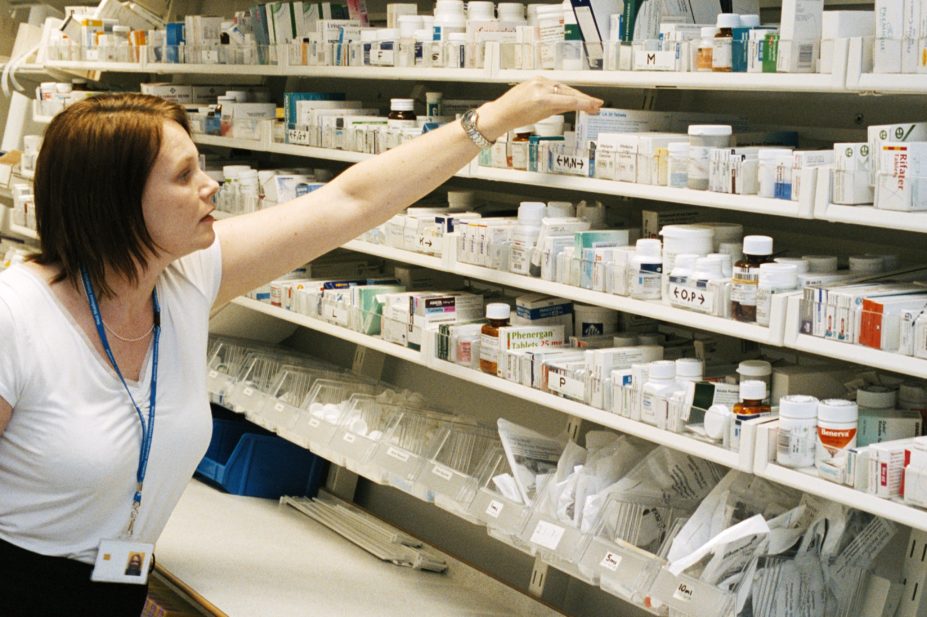
Science Photo Library
The scope of pharmacy practice has expanded in recent years, owing to the introduction of medicines review and consultation services, but medicines dispensing remains a core feature of pharmacy work [1],[2],[3]
. Pharmacists and their teams should, therefore, be able to manage the potential risk of dispensing errors, which account for 15.9% of the 237.4 million medication errors that occur in England each year[4]
.
This article is the first of a two-part series on dispensing errors. Part one examines why and how dispensing errors might happen and outlines principles for managing the risk associated with them. Part two will examine methods for their prevention and how pharmacists can address dispensing errors in practice.
What is a dispensing error?
A systematic review of dispensing error research by James et al. allowed the authors to define a dispensing error as the “deviation from a written prescription that occurs during the dispensing process”[5]
. In this context, examples of a deviation could include a:
- Dose/item error — where the wrong item is selected or assembled;
- Labelling error — where the item is correct, but the label is incorrect;
- Issue error — where the order is issued to the wrong patient or not issued at all;
- Documentation error — where the order is correctly issued but incorrectly documented[5]
.
Within James et al.’s definition, it is possible to distinguish between an unprevented error and prevented error. An unprevented error is the exposure of a patient to potential harm, whether or not harm results; for example, a patient receiving incorrect medication from a pharmacy[5]
.
A prevented error is a situation that could have led to such exposure, had it not been stopped; for example, incorrect medication is picked for a patient during dispensing, but this discrepancy is detected and corrected before it is handed out.
It should be noted that harm is defined by the World Health Organization as “mental or physical impairment resulting from healthcare activities, or any effect of such an impairment (e.g. disease, injury, suffering, disability or death)”[6]
.
What errors occur in practice?
Dispensing errors can occur anywhere that medicine is given to a patient, including community pharmacy, hospital pharmacy and by dispensing doctors.
The National Reporting and Learning System (NRLS) collects incidents from community pharmacy practice in England and Wales[7]
. Recent reviews of 14,704 incidents reported to the NRLS between 2005 and 2010 found that the most commonly reported errors in community pharmacy were:
- Wrong dose/strength (30.3%);
- Wrong medicine (28%);
- Wrong formulation (12%);
- Wrong quantity (9%)[8],[9]
.
The vast majority of errors (92%, [n=13,573]) did not result in any harm and few (< 1% [n=29]) resulted in severe harm or death[8],[9]
.
The medicines most commonly implicated are amitriptyline, amlodipine, insulin, methadone and morphine (presumably owing to their relatively narrow therapeutic range and potential for adverse side effects).
In a review of research on hospital dispensing errors, James et al. made the following observations:
- Wrong drug and strength were the most common unprevented errors;
- Wrong directions on the label, wrong drug and wrong strength were the most common prevented errors;
- Labelling errors were a common problem in automated dispensing[10]
.
Why do dispensing errors happen?
As it currently stands, dispensing greatly depends on human input, whether this is assessing the clinical appropriateness of prescriptions, interpreting prescriptions and finding the appropriate items to fulfil them, or making sure that the order has been correctly fulfilled. Research by Grasha et al. noted that the individuals involved in dispensing may need to process various items of information that vary in their volume and complexity, creating a degree of mental demand[11]
. Surrounding this process is the setting in which the work is taking place. Holden et al. use five categories to describe the relevant characteristics of a healthcare setting, including:
- People involved (e.g. pharmacists, technicians, dispensers, prescribers, patients);
- Tasks that are being carried out (e.g. reading scripts, arranging stock);
- Physical environment (e.g. lighting, noise, heat);
- Tools and technology that are being used (e.g. patient medication records, barcode scanners, measuring devices);
- Organisational structure within which the work is being conducted (e.g. communication networks, organisational priorities, allocation of responsibilities)[12]
.
Ideally, the characteristics of the setting support safe and effective dispensing, either by helping the task to be performed correctly or by allowing any potential errors to be detected and remediated. However, problems can arise in relation to any of the characteristics, which create points of vulnerability in the pharmacy. In this respect, the characteristics referred to by Holden et al. are broadly equivalent to the “blunt end” and “error producing conditions” in Reason’s accident causation model[13]
. The Table lists examples of pharmacy characteristics associated with safe dispensing[5],[6],[14],[15],[16],[17]
.
| Table: Pharmacy characteristics that relate to safe dispensing | ||
|---|---|---|
| Characteristics that support safe dispensing | Characteristics that undermine safe dispensing | |
| People |
|
|
| Tasks |
|
|
| Physical environment |
|
|
| Tools and technology |
|
|
| Organisational structure |
|
|
| Source: James KL[5] ; World Health Organization[6] ; Research in Social and Administrative Pharmacy [14],[15] ; BMC Health Services Research [16] ; Ergonomics [17] . | ||
Consistent with Reason’s model, if enough vulnerabilities come together then the opportunity for a dispensing error increases[13]
. However, there are various reasons why a given vulnerability, or combination of vulnerabilities, may not be recognised, such as:
- The vulnerability not being easily recognised. For example, it might not be obvious that a patient medication record is no longer up-to-date following changes in medicines prescribed or used;
- Staff have adapted to the presence of the vulnerability. For example, they have become used to working in a pharmacy that is poorly laid out and cluttered;
- The vulnerability does not always lead to an error. For example, staff may often work outside their formal standard operating procedures in order to achieve their work objectives, usually with no obvious negative consequences;
- The vulnerability may be overlooked in the investigation of previous incidents to which it contributed. For example, it may have been assumed that the ‘cause’ of an item being incorrectly picked was a member of staff not concentrating. However, if the investigation does not go into sufficient depth and consider other issues that may have contributed, then the opportunity to prevent future issues is not addressed[18],[19]
.
It is necessary to reflect on the above points as those characteristics of the pharmacy that are usually benign, or even benefit work, can allow a near-miss or incident to occur.
Managing dispensing error risk
Two basic principles summarise how the risk of dispensing errors can be managed:
- Identifying characteristics of the pharmacy that support safe dispensing (see Table) and ensuring that these can operate;
- Identifying characteristics that undermine safe dispensing (see Table) and ensuring that these (or their effects) are controlled.
In the design and day-to-day operation of dispensing, an important method of managing risk is the implementation of risk controls — these are characteristics of the pharmacy that serve to stop an error from occurring, or from leading to harm if it does occur[20]
. The more varied and reliable the controls, the better prepared the pharmacy will be to manage risk in dispensing[21]
.
In general terms, there are four types of controls in pharmacy:
- Administrative — such as checklists, protocols, audits and appraisals;
- Social — such as team, branch or professional group conventions about work practice;
- Self — such as personal attitudes, preferences and habits;
- Technical — such as computer alerts and ‘lockouts’ (i.e. features of the equipment that allow them to be used only in a specific and correct manner)[22]
.
Generally, the most effective controls are those that eliminate errors at source (e.g. by removing a brand of medication that is particularly prone to being dispensed in error). The next most effective controls are those that contain the characteristics that could give rise to an error (e.g. by restricting monitored dosage system dispensing to particular dispensary locations). The weakest controls are typically those that place the onus on people to take control actions themselves (e.g. placing a label next to an item that is prone to being confused for another)[23]
. This does not mean that only those controls that eliminate errors at source are worthwhile, but it does mean that relying only on a small number of weaker controls will limit the ability to deal with the range of errors that could occur. It is important to note that some of the ways in which errors might occur may not be immediately apparent.
Part two of this dispensing errors series will examine methods for error prevention and how pharmacists can address dispensing errors in practice. For best practice in relation to ensuring safe dispensing, see Box.
Best practice
When reflecting on how pharmacy teams can help improve patient safety, it is essential to reflect on your own practices of safe dispensing, including ensuring:
- Staff are well-trained and motivated;
- Tasks are designed and scheduled in a way that allows them to be easily carried out;
- The physical environment is comfortable and supportive;
- Tools are easy to access and use;
- The organisational structure fosters effective team working and information sharing.
In order to provide these practices, there needs to be a collaboration between senior managers and frontline staff, as well as alignment between organisational policies and day-to-day operational work. Although it may take time, it is necessary to prevent inadvertent harm to the increasing number of patients seeking services from the pharmacy, which will be further examined in part two of this series.
About the authors
Denham Phipps is a lecturer, Ahmed Ashour is a doctoral student, Lisa Riste is a research fellow, Penny Lewis is a clinical lecturer, and Darren Ashcroft is a professor, all based in the School of Health Sciences and the NIHR Greater Manchester Patient Safety Translational Research Centre, The University of Manchester.
Useful resources
The authors have recently produced a learning package on patient safety for pharmacy staff in conjunction with the Centre for Pharmacy Postgraduate Education. More details are available at: www.cppe.ac.uk/programmes/l/safety-e-01.
References
[1] Royal Pharmaceutical Society. The RPS advanced pharmacy framework. 2013. Available at: https://www.rpharms.com/Portals/0/RPS%20document%20library/Open%20access/Frameworks/RPS%20Advanced%20Pharmacy%20Framework.pdf (accessed November 2020)
[2] Pharmaceutical Services Negotiation Committee. Advanced services. 2020. Available at: https://psnc.org.uk/services-commissioning/advanced-services/ (accessed November 2020)
[3] The Pharmaceutical Journal. Is it time for community pharmacy to let go of dispensing? 2018. Available at: https://www.pharmaceutical-journal.com/opinion/editorial/is-it-time-for-community-pharmacy-to-let-go-of-dispensing/20205452.article?firstPass=false (accessed November 2020)
[4] Connelly D. Medication errors: where do they happen? 2019. Available at: https://www.pharmaceutical-journal.com/news-and-analysis/infographics/medication-errors-where-do-they-happen/20206204.article (accessed November 2020)
[5] James KL. Dispensing medication. In Tully M, Dean Franklin B (eds.), Safety in Medication Use. Boca Raton, Florida: CRC Press; 2015. p. 19–33.
[6] World Health Organization. Conceptual framework for the international classification for patient safety, version 1.1. 2009. Available at: https://www.who.int/patientsafety/taxonomy/icps_full_report.pdf (accessed November 2020)
[7] NHS Improvement. The National Reporting and Learning System. 2020. Available at: https://report.nrls.nhs.uk/nrlsreporting/Default.aspx (accessed November 2020)
[8] Phipps DL, Tam WV & Ashcroft DM. Integrating data from the UK National Reporting and Learning System with work domain analysis to understand patient safety incidents in community pharmacy. J Patient Saf 2017;13(1):6–13. doi: 10.1097/PTS.0000000000000090
[9] Muhammad KW, Carson-Stevens A, Williams H et al. 2016. Medication safety incidents reported to the National Reporting and Learning System in England and Wales: a review of primary care incidents classified as severe harm and death. Int J Pharm Prac 2016;24(Suppl. 3):0108. Available at: https://www.researchgate.net/publication/307834424_Medication_safety_incidents_reported_to_the_National_Reporting_and_Learning_system_in_England_and_Wales_A_review_of_primary_care_incidents_classified_as_severe_harm_and_death (accessed November 2020)
[10] James KL, Barlow D, McArtney R et al. Incidence, type and causes of medication errors: a review of the literature. Int J Pharm Prac 2009;17:9-30. doi: 10.1211/ijpp.17.1.0004
[11] Grasha AF. Into the abyss: seven principles for identifying the causes of and preventing human error in systems. Am J Health Syst Pharm 2000;57(6):554–564. doi: 10.1093/ajhp/57.6.554
[12] Holden RJ, Carayon P, Gurses AP et al. SEIPS 2.0: a human factors framework for studying and improving the work of healthcare professionals and patients. Ergonomics 2012;56(11):1669–1686. doi: 10.1080/00140139.2013.838643
[13] Garfield S & Dean Franklin B. Understanding models of error and how they apply in clinical practice. Pharm J 2016;296:361–364. doi: 10.1211/PJ.2016.20201110
[14] Harvey J, Avery AJ, Ashcroft D et al. Exploring safety systems for dispensing in community pharmacies: focusing on how staff relate to organizational components. Res Social Adm Pharm 2015;11(2):216-227. doi: 10.1016/j.sapharm.2014.06.005
[15] Weir NM, Newham R & Bennie M. A literature review of human factors and ergonomics within the pharmacy dispensing process. Res Social Adm Pharm. 2020 May;16(5):637–645. doi: 10.1016/j.sapharm.2019.08.029
[16] Phipps DL, Noyce PR, Parker D et al. Medication safety in community pharmacy: a qualitative study of the sociotechnical context. BMC Health Serv Res 2009;9:158. doi: 10.1186/1472-6963-9-158
[17] Hignett S, Lang A, Pickup L et al. More holes than cheese: what prevents the delivery of effective, high quality and safe health care in England? Ergonomics 2018;61(1):5–14. doi: 10.1080/00140139.2016.1245446
[18] Jones CEL, Phipps DL & Ashcroft DM. Understanding procedural violations using Safety-I and Safety-II: the case of community pharmacies. Saf Sci 2018;105:114–120. doi: 10.1016/j.ssci.2018.02.00
[19] Peerally MF, Carr S, Waring J & Dixon-Woods M. The problem with root cause analysis. BMJ Qual Saf. 2017;26(5):417–422. doi: 10.1136/bmjqs-2016-005511
[20] Health and Safety Executive. Managing for Health and Safety. 2013. Available at: https://www.hse.gov.uk/pubns/books/HSG65.htm (accessed November 2020)
[21] Hudson PTW & Guchelaar H-J. Risk assessment in clinical pharmacy. Pharm World Sci 2003;25(3):98–103. doi: 10.1023/a:1024068817085
[22] Reason J, Parker D & Lawton R. Organizational controls and safety: the varieties of rule-related behaviour. J Occup Organ Psychol 1998;71(4):289–304. doi: 10.1111/j.2044-8325.1998.tb00678.x
[23] de Castro AB. ‘Hierarchy of controls’: providing a framework for addressing workplace hazards. Am J Nurs 2003;103:104. Available at: https://journals.lww.com/ajnonline/Citation/2003/12000/_Hierarchy_of_Controls___Providing_a_framework_for.30.aspx


